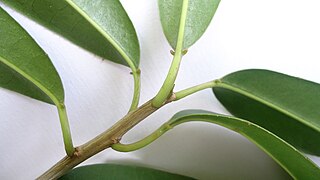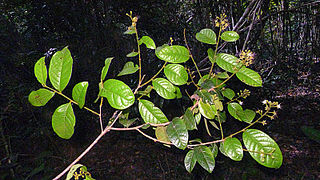| Plinia | |
|---|---|
 | |
| P. cauliflora | |
| Scientific classification | |
| Kingdom: | Plantae |
| Clade: | Tracheophytes |
| Clade: | Angiosperms |
| Clade: | Eudicots |
| Clade: | Rosids |
| Order: | Myrtales |
| Family: | Myrtaceae |
| Subfamily: | Myrtoideae |
| Tribe: | Myrteae |
| Genus: | Plinia L. [1] not Blanco 1837 (syn of Kayea in Clusiaceae) |
| Synonyms [2] | |
| |
Plinia is a genus of flowering plants in the myrtle family, Myrtaceae described by Linnaeus in 1753. [3] [4] It is native to Central and South America as well as the West Indies. [2] [5] [6] [7] [8]
- Species [2] [9]
- Plinia abeggii - Hispaniola
- Plinia anonyma - SE Brazil
- Plinia arenicola - W Cuba
- Plinia asa-grayi - Cuba
- Plinia baileyi - Trinidad and Tobago
- Plinia baracoensis - Cuba
- Plinia brachybotrya - S Brazil
- Plinia callosa - Bahia
- Plinia caricensis - Hispaniola
- Plinia cauliflora - S Brazil, Bolivia
- Plinia cerrocampanensis - Panama
- Plinia cidrensis - Massif du Nord in Haiti
- Plinia clausa - N Peru
- Plinia coclensis - Panama
- Plinia complanata - São Paulo
- Plinia cordifolia - S Brazil
- Plinia coronata - SE Brazil
- Plinia costata - Guyana, Suriname
- Plinia cubensis - Cuba
- Plinia cuspidata - Costa Rica, Panama
- Plinia darienensis - Panama
- Plinia dermatodes - Cuba
- Plinia duplipilosa - Loreto
- Plinia edulis - S Brazil, NE Argentina
- Plinia ekmaniana - Massif du Nord in Haiti
- Plinia espinhacensis - Minas Gerais
- Plinia formosa - Cuba
- Plinia gentryi - Panama
- Plinia grandifolia - S Brazil
- Plinia guanacastensis - Costa Rica
- Plinia hatschbachii - Paraná
- Plinia icardiana - Massif de la Hotte
- Plinia ilhensis - Rio de Janeiro
- Plinia inflata - N Brazil
- Plinia involucrata - N Brazil, Venezuela
- Plinia longiacuminata - Bahia
- Plinia martinellii - Rio de Janeiro
- Plinia microcycla - Dominican Rep
- Plinia moaensis - Cuba
- Plinia moralesii - Costa Rica
- Plinia muricata - Bahia
- Plinia nana - Minas Gerais
- Plinia nicaraguensis - Costa Rica, Nicaragua
- Plinia oblongata - São Paulo
- Plinia orthoclada - Cuba
- Plinia panamensis - Panama
- Plinia pauciflora - São Paulo
- Plinia peroblata - Belize
- Plinia peruviana - Peru, Bolivia, Brazil, Paraguay, NE Argentina
- Plinia phitrantha - São Paulo, Minas Gerais
- Plinia pinnata - Lesser Antilles, Trinidad
- Plinia povedae - Guatemala, Costa Rica, Panama
- Plinia punctata - Cuba
- Plinia puriscalensis - Costa Rica
- Plinia ramosissima - Cuba
- Plinia rara - Bahia
- † Plinia recurvata - Cuba but extinct
- Plinia renatiana - Espírito Santo
- Plinia rivularis - Trinidad, Venezuela, Brazil, Paraguay, Uruguay, NE Argentina
- Plinia rogersiana - São Paulo
- Plinia salamancana - Panama
- Plinia salticola - Costa Rica, Panama
- Plinia sebastianopolitana - Rio de Janeiro
- Plinia spiciflora - E Brazil
- Plinia spirito-santensis - SE Brazil
- Plinia stenophylla - Cuba
- Plinia subavenia - Espírito Santo, Bahia
- Plinia yasuniana - Yasuni National Park, Ecuador
















